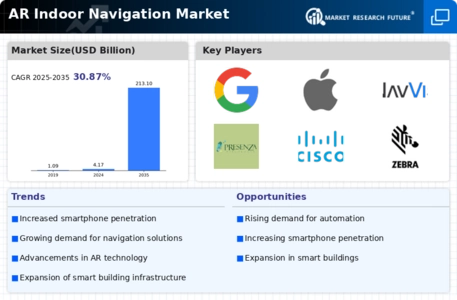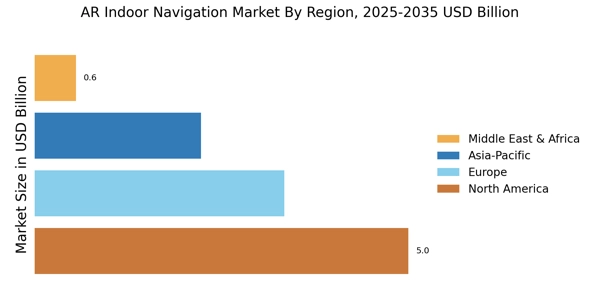Enhanced User Experience
The AR Indoor Navigation Market is witnessing a surge in demand due to the enhanced user experience it offers. By integrating augmented reality with indoor navigation, users can receive real-time, interactive guidance within complex environments such as malls, airports, and museums. This technology allows for personalized navigation, which can significantly improve user satisfaction. According to recent estimates, the user engagement in applications utilizing AR for navigation has increased by over 30% in the last year. As businesses recognize the value of providing a seamless and engaging experience, investments in AR indoor navigation solutions are likely to rise, further driving market growth.
Advancements in AR Technology
The AR Indoor Navigation Market is benefiting from rapid advancements in augmented reality technology. Innovations in hardware, such as improved sensors and mobile devices, are enabling more accurate and efficient indoor navigation solutions. Furthermore, software developments, including machine learning algorithms, are enhancing the ability to process spatial data in real-time. These technological improvements are making AR indoor navigation more accessible and user-friendly. As the technology matures, it is expected that adoption rates will increase, leading to a more competitive market landscape. Analysts predict that the AR technology market will grow at a compound annual growth rate of over 40%, indicating a promising future for AR indoor navigation applications.
Increased Investment in AR Startups
The AR Indoor Navigation Market is experiencing a wave of investment in startups focused on augmented reality solutions. Venture capitalists and tech investors are recognizing the potential of AR technologies to transform various sectors, including navigation. This influx of capital is fostering innovation and accelerating the development of new AR indoor navigation applications. Recent funding rounds have seen startups raising millions to enhance their offerings, suggesting a strong belief in the market's future. As these startups continue to innovate and refine their technologies, the overall AR indoor navigation market is likely to expand, driven by fresh ideas and competitive solutions.
Growing Demand for Smart City Solutions
The AR Indoor Navigation Market is being propelled by the increasing focus on smart city initiatives. Urban planners and local governments are exploring innovative technologies to enhance public services and improve the quality of life for residents. AR indoor navigation systems can facilitate better wayfinding in public buildings, transportation hubs, and other civic spaces. As cities become more interconnected, the need for efficient navigation solutions is becoming more pronounced. Reports indicate that investments in smart city technologies are expected to reach trillions of dollars in the coming years, suggesting a robust opportunity for AR indoor navigation solutions to play a pivotal role in urban development.
Rise of E-commerce and Omnichannel Retailing
The AR Indoor Navigation Market is significantly influenced by the rise of e-commerce and the shift towards omnichannel retailing. Retailers are increasingly adopting AR technologies to bridge the gap between online and offline shopping experiences. By providing customers with interactive navigation tools within physical stores, retailers can enhance product discovery and streamline the shopping process. Data indicates that retailers utilizing AR solutions have seen a 20% increase in foot traffic and a 15% boost in sales conversion rates. This trend suggests that as e-commerce continues to evolve, the demand for AR indoor navigation solutions will likely expand, creating new avenues for growth in the market.


















Leave a Comment